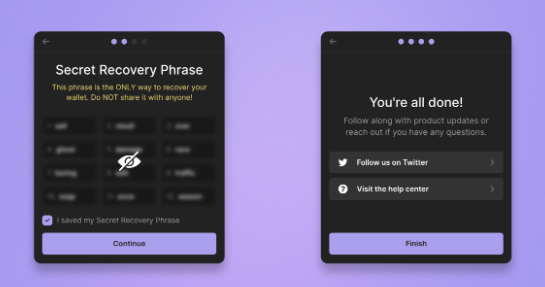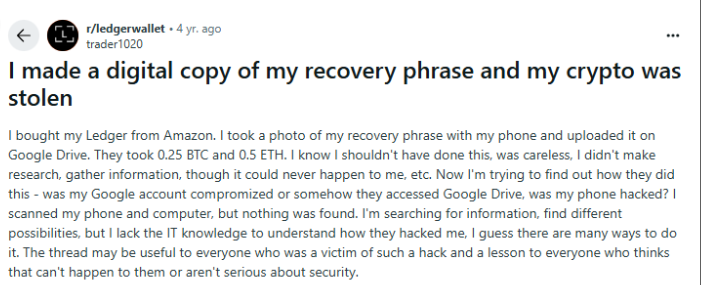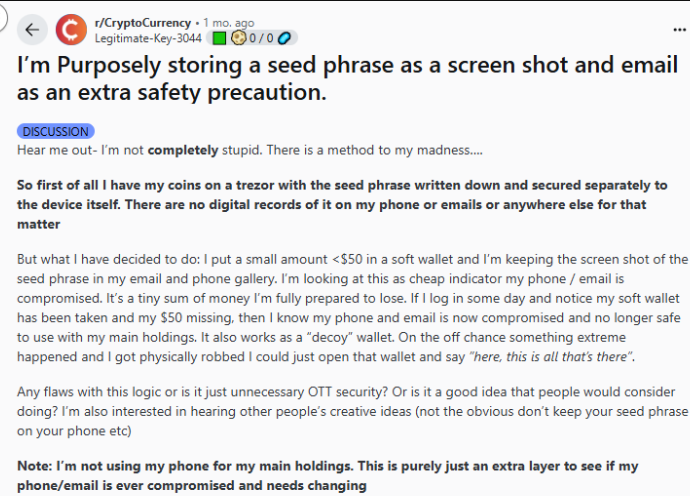Just got to know that your crypto wallet is gone, no access, no funds, no recovery. What happened? Often, it’s because the recovery phrase, sometimes called the seed phrase or secret recovery phrase, was lost, leaked, or stored insecurely.
It is the master key to your wallet. With it, anyone can control all your assets. Without it, you can’t recover access. MetaMask and Phantom are popular self-custodial wallets where you control your keys and your recovery phrase. That’s great for privacy, control, and security, but it also means you are fully responsible for safeguarding them.
In this blog you’ll learn where you should store your recovery phrase for Metamask/Phantom, how to store it safely, and what mistakes to avoid.
Your credentials may be at risk.
Run a free email scan to see if your data has been exposed — no signup needed.
What is the Recovery / Secret Seed Phrase?
A recovery phrase is a series of 12 (sometimes 24) words generated by your wallet (MetaMask or Phantom) that uniquely corresponds to your private keys. It is a sort of master keyring for all your accounts tied to that wallet.
MetaMask calls it Secret Recovery Phrase (SRP). It is generated when you first set up the wallet. Phantom also uses a 12-word Secret Recovery Phrase. It’s the only way to restore your wallet on new devices, after uninstall or migration.

Why Proper Storage of Your Recovery Phrase is Important?
Your recovery phrase is the ultimate key to your MetaMask or Phantom wallet; lose it, and your funds are gone forever. If it falls into the wrong hands, hackers can instantly drain your assets with no way to reverse the damage. That’s why storing it properly isn’t optional; it’s the foundation of your crypto security. Here’s why:
- Total access if compromised: Anyone who gets your recovery phrase can move all your funds. There’s no “forgot password” recovery in most cases.
- Irrecoverable loss if lost: If you lose the phrase and cannot retrieve it, you lose access permanently. Even support from MetaMask or Phantom cannot restore access without it.
- Threat vectors: Digital theft (malware, phishing), physical risks (fire, flood, theft), decay (paper fading), and human error (writing mistakes, misplacement) all threaten your backup.
- Compliance & safety mindset: For high-value, institutional, or long-term holdings, storing securely is as important as choosing a strong wallet.
What are the Best Practices for Physical Storage of Your Recovery Phrase
Physical storage remains the foundation of safety for recovery phrases. Here’s what to do:
Paper Backups
- Use high quality, acid-free paper or archival paper so ink doesn’t fade or bleed.
- Use permanent ink / archival pen. Avoid ballpoint ink that smears.
- Write clearly; double check spelling and word order. One mis-spelled word or wrong order can break restoration.
- Store in a sealed bag or envelope to protect from moisture.
Keep more than one copy, but stored in different secure locations (e.g. safe in your home, safe deposit box, a trusted relative’s safe).
Metal / Fireproof / Waterproof Storage
- Metal plates (stainless steel, titanium) designed for seed phrases resist fire, water, pests, decay.
- Brands exist (for example in the broader crypto community) that let you stamp or engrave the words.
- Store the metal backup in a safe or strongbox with protection against fire or flood.
Multiple Physical Locations
- Don’t keep all backups in one place. For example: one at home, one in a bank deposit box, one at a trusted location.
- Use geographically separated locations if possible (to avoid risks from regional natural disasters).
Tamper-Resistant Containers
- Use safes (fireproof/waterproof), lock-boxes, or other containers that are hard for unauthorized people to access.
- Consider tamper-evident seals or packaging so you’ll notice if someone tried to access your backup.
Best Practices for Digital Storage of Your Recovery Phrase
Digital storage is more convenient but much riskier. Only use digital backups if you understand and mitigate the risks.
Air-Gapped Devices
- Use a device that is never connected to the internet, an old laptop, a dedicated USB drive or hardware that remains offline.
- Use it only for backups, not for browsing or email.

Encrypted Backups
- Encrypt your backup file using strong encryption (AES-256 or equivalent).
- Use strong passphrases; avoid reusing passwords.
Offline USBs / Hardware Devices
- Use hardware wallets or secure USB drives (preferably with pin / encryption) to store encrypted backup.
- Keep them in secure locations.
What Mistakes to Avoid When Storing Your Recovery Phrase Digitally
Cloud storage like Google Drive, iCloud, or Dropbox might seem convenient, but plenty of Reddit users warn how risky it is; breaches, leaks, or even mistaken backups can expose your recovery phrase. In fact, MetaMask explicitly tells its users not to store their Secret Recovery Phrase (SRP) online.
Don’t take screenshots of your seed phrase or stash it in an email draft; those are just digital breadcrumbs waiting for someone to follow.
Also, avoid obvious file names (think “seed phrase.txt” or “my_secret_recovery_phrase.doc”), anything too easy to find is basically screaming “steal me.”

What MetaMask & Phantom Say About Recovery Phrase Storage
Both MetaMask and Phantom keep it simple when it comes to your recovery phrase: write it down, keep it offline, and never share it with anyone. But let’s break that down a bit more.
MetaMask’s Guidelines
- MetaMask recommends old-school storage; write your Secret Recovery Phrase (SRP) on paper and hide it somewhere safe, like a fireproof safe or even a bank safety deposit box.
- Some power users go further and engrave their phrase onto a steel or titanium plate so it survives fire, water, or wear.
- One golden rule MetaMask repeats: never store your SRP online, not in Google Drive, iCloud, Dropbox, emails, or screenshots.
- MetaMask cannot reset or recover your phrase if you lose it. You’re the only one who has it.
Phantom’s Guidelines
- Phantom also generates a 12-word recovery phrase, and their advice is the same as MetaMask: write it down and keep it offline.
- They stress that Phantom will never ask for your recovery phrase; if someone does, it’s a scam.
- If you think your phrase has been exposed, Phantom actually suggests migrating your funds into a brand-new wallet with a fresh phrase and this time, making sure it’s backed up securely.
Both wallets put the responsibility squarely on you. Guard your recovery phrase like a treasure.
How to Test Your Recovery Phase Backup
So you’ve written down your recovery phrase and tucked it away safely, great start. But how do you know it actually works? Give it a little test run.
Try restoring your phrase in a test wallet, either on a spare device or by creating a temporary wallet inside MetaMask or Phantom. This way, you can confirm every word is correct without putting your real funds at risk.
Double-check spelling and order. Even a single wrong word will stop the wallet from restoring, so this is your safety net. Now and then, peek at your backup itself. Is the ink on your paper still readable? Is that metal plate still clear and legible? A quick check today can save you from heartbreak later.

Protect Your Recovery Phrase with PureVPN’s Password Manager
We’ve talked a lot about writing down your recovery phrase, keeping it offline, and more, but let’s be honest, it is too risky. But a secure password manager can help.
PureVPN’s Password Manager is built to keep your most sensitive information, from email logins to banking passwords to your MetaMask or Phantom recovery phrase, safe in one encrypted vault. Here’s why it’s worth considering:
- End-to-end encryption: Your data is encrypted locally before it even leaves your device, meaning only you hold the master key. Even PureVPN can’t see what’s inside.
- One master password: Instead of juggling dozens of passwords and secret phrases, you just need to remember one strong master password.
- Cross-device access (with security): Need your wallet backup while traveling? You can securely access your vault across devices without emailing or screenshotting anything.
- Breached password monitoring: The manager also alerts you if your saved credentials ever show up in a data breach, giving you time to act fast.
This way, you avoid risky habits like dumping your recovery phrase into a “notes” app or cloud storage. Plus, you get the convenience of digital storage with the security of next-generation encryption.
Conclusion
Your recovery phrase isn’t just another password; it’s the backbone of your crypto security. When you use MetaMask or Phantom, you get powerful control, but with that comes serious responsibility. The right storage strategy is essential.
Stay safe, stay private, and manage your privacy with PureVPN.
Frequently Asked Questions
Storing your recovery phrase or any of the passwords with PureVPN’s password manager is the single most secure way to keep them secure without the hassle of remembering or keeping repetitive passwords.
It is not recommended. Both MetaMask and security experts warn that storing SRP online exposes it to hacking, phishing, and cloud service vulnerabilities. If you must, ensure strong encryption and offline, air-gapped storage.
Immediately export/reveal the phrase using the wallet settings, write it down and secure it using the best practice methods above. Then consider rotating or migrating to a new wallet with a new phrase if you suspect it may have been exposed.
No. Both MetaMask and Phantom support pages explicitly state they will never ask for your recovery phrase. Sharing it with anyone (even those claiming to be support) is risky.
Once every few months is good. Check physical copies for decay or damage. Ensure that your encrypted digital backup can still be decrypted. And ensure any hardware or devices involved are still functioning.









